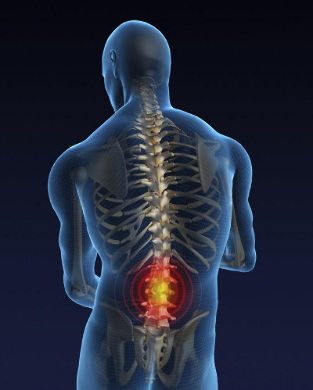In some cases, it can be challenging for the patient standing up. As it may take several days for a few weeks until acute low back pain.

Causes of acute low back pain
Most people back pain at least once in their life that I lived. Though it may appear as pain or discomfort at any one level are affected more often so the waist area. This problem occurs because the uterus only to have to withstand the weight of the body and head.
Back pain - a frequency second excuse a doctor, second only to colds and flu.
Usually, acute low back pain for the first time visible after the abolition of a heavy object, a sudden movement, injury or a sitting posture for long periods.
Acute low back pain is most often a result of sudden traumatization and bond Nov back, disc herniation, lumbar. Pain, in such cases, the cause may be, Nov spasm, sprain or rupture, and bond Nov.
Sudden back pain causes include:
- vertebral compression fractures due to osteoporosis or injury;
- spasm Nov (Nov extreme tension);
- hernia;
- sciatica;
- spinal stenosis (a narrowing) of the spinal canal);
- curvature of the spine (eg scoliosis or kyphosis), including illness-president of Mau;
- withdrawals/rupture, or bond Nov back;
- spondylosis;
- spondylolisthesis;
- spinal infection (diskit, abscess.
Acute low back pain may cause the following systemic diseases:
- diffuse connective tissue disease;
- ankylosing spondylitis;
- malignant tumor, spine;
- rheumatoid arthritis.
Causes of acute low back pain, problems with the spine or tissues back:
- abdominal aortic aneurysm;
- gastrointestinal disease: pancreatitis, gastric ulcer, cholecystitis;
- herpes zoster;
- disease pelvic inflammatory disease: endometriosis, prostatitis, pelvic inflammatory disease;
- retroperitoneum disease: renal colic, urinary;
- pregnancy.
Symptoms
Acute low back pain significantly symptoms will vary depending on his reasons. You feel numbness, tingling, the nature of pain may be different, and also the severity of the pain: mild pain discomfort from extreme weather and Meteo stand. In addition, low back pain, often go, pain with the legs, hips and feet. In some cases, it may seem that leg weakness.
Here are a few examples of the symptoms of various diseases and conditions that are specific:
- an intervertebral hernia: low back pain, foot and leg pain aggravated after sitting or sleeping position frequent back pain and stronger. That can give you low back pain hips, thighs and down the leg foot. You may experience tingling, numbness, legs and feet, in rare cases - Nov foot weakness;
- stretching the muscles, waist: diffuse pain, gives you a leg or hip; improved ride and attenuated resting;
- spinal canal stenosis: low back pain and stronger foot and leg pain low back pain, frequent development of spinal stenosis, intervertebral hernia; standing and walking aggravated, attenuated, twisted and back rest. The pain may be single-sided and double-sided;
- diffuse connective tissue disease: pain pain in multiple joints, fever, weight loss, weakness;
- a osteomyelitis: constant pain, usually normal temperature; normal complete blood count, increased erythrocyte sedimentation rate (ESR) and/or levels of C-reactive protein.
Diagnosis
Consulting your doctor will make the patient with a speech by asking questions about the nature and severity of the pain and other symptoms collect this information, it will perform a history and physical examination. Speech and data based on Doctor's examination, diagnosis or pre-diagnosis, confirmation and/or medical tests with clarity. The medical tests may be different, started, blood tests and nerve conduction studies completed. The most popular surveys include the following:
X-ray

Held radiography to assess bone health patient. Between radiography diagnosis with osteoporosis, compression fractures, and bone growth (osteophyte);
Magnetic resonance imaging (MRI)
MRI MRI is the advantage before other research can be obtained through high-quality, detailed images not only of bone but also soft tissue muscles, ligaments, blood vessels, nerves, intervertebral disc, spinal cord, etc.
The most common diagnosis MRI findings:
- intervertebral hernia;
- narrowing (stenosis) spinal canal;
- spondylitis.
Other diagnoses which can be diagnosed with MRI:
- ankylosing spondylitis (a type of arthritis);
- bone infection;
- cauda equina syndrome
- compression fractures;
- diskit (inflammation of the intervertebral disc);
- spinal cord abscess;
- spinal cord injury;
- inflatable spine.
Computed tomography (CT)
Computed tomography, allow to get too, not just an image, a bone, but at the same time, soft-tissue, but much lower quality MRI image quality when shooting handheld, therefore, it is advisable to in the event that for some reason are difficult or impossible Mr if, for example, a pacemaker or metal body design.
Treatment
Acute low back pain what you can do in the home?
- limitation of physical activity 1-2 days. This will help to remove mild to moderate symptoms and painful and inflamed region;
- feeding, a heating pad or ice to the painful region;
- purchase over the counter pain relief medications. This is specified a greater number of drugs not listed in the instructions if you need to take the drug at the most 3 days. During this time, pain - you should see a doctor.
Embryo and put a pillow between the legs to get a better position during sleep. If you used to sleep is on your back, pillow under the knee to remove a burden or roller towels.
The reason low back pain is more serious, then the special treatment required for the sick, depending on an illness or condition caused by helping professionals already here that the sensation of pain and can't do without.
One of the most common causes of acute low back pain, the need for a special treat, intervertebral hernia. Treatment of intervertebral hernia is usually conservative, only from time to time physicians have to resort to surgical methods. Many conservative treatment methods for intervertebral hernia. Here are just a few of them:
- It is treated with medication. Drug therapy includes the intake of pain killers and anti-inflammatory drugs.
- The traction of the spine. Not traction compared to shooting such a load or stress leads to complications in the vector table. The spine traction provides feedback and partially as a result of intervertebral disc and intervertebral hernia to reduce the size of the incentive of the state;
- Therapeutic massage. Medical massage differs from any. In general, this method aims to achieve relaxation of the back muscles, tension, spasms Nov, usually with concomitant low back pain;
- Therapeutic exercises. Gymnastics aims to strengthen the small back muscles;
- Leech therapy
Hernia around leech therapy reduces inflammation, reduces pain syndrome. Another alternative analgesic drugs. - Surgical treatment. Intervertebral hernia surgical treatment is recommended for only for patients, but not routinely and systematically provided in this treatment help cure ways conservative, the patients started treatment with significant neurological deficits as well as symptoms: weakness, leg paralysis, stroke, foot numbness, spoon, violation control features urination and/or defecation. Spine surgery an emergency meeting to read all of the above symptoms.

























